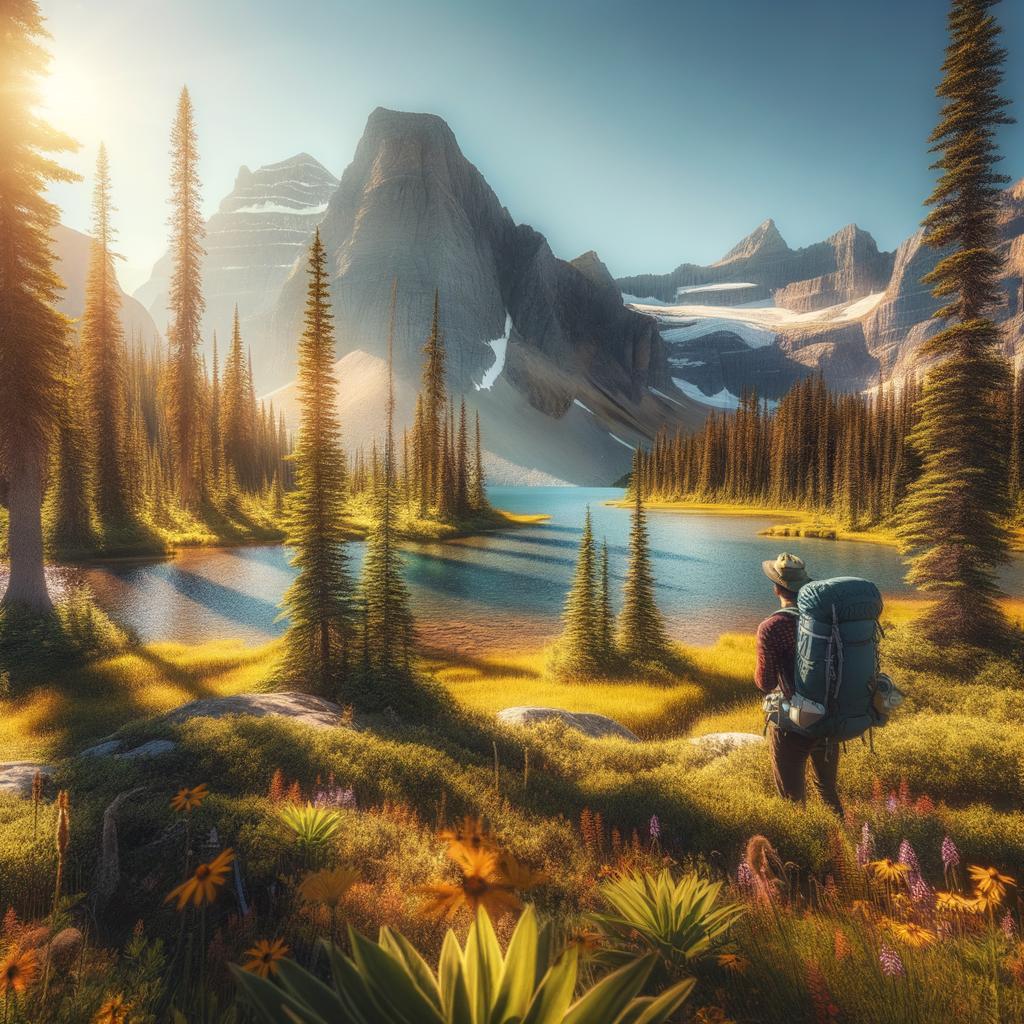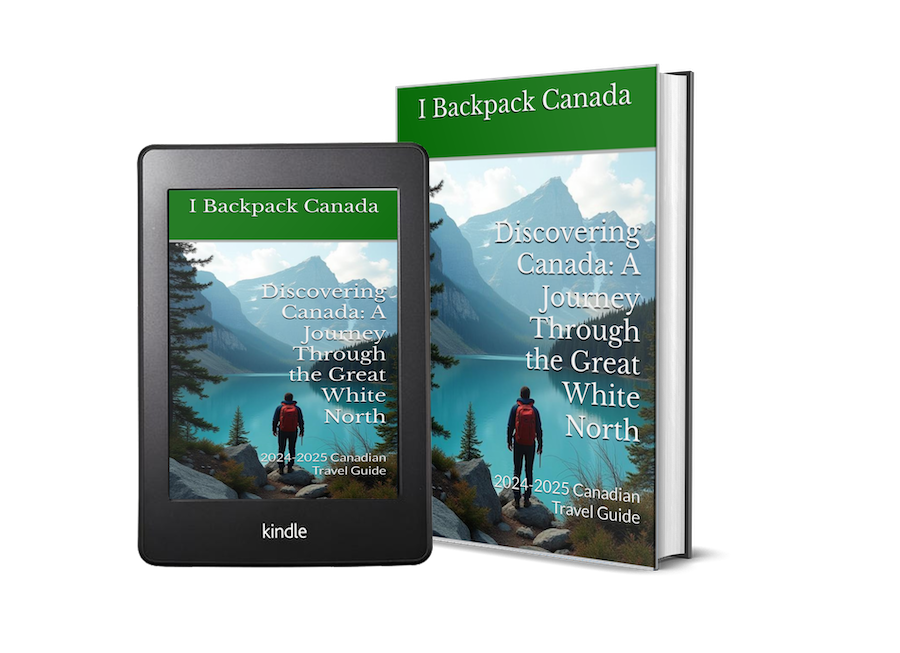Explore Canada in 2024-2025 The Ultimate Backpacking Travel Guide for Adventure Seekers
Posted on September 8, 2024 • 17 minutes • 3599 words
Table of contents
Canada, the second-largest country in the world by land area, offers an incredible diversity of landscapes, cultures, and experiences for backpackers. From the rugged coastlines of the Atlantic and Pacific to the towering peaks of the Rockies, and from the vibrant cities to the remote wilderness of the North, Canada has something for every type of traveler. This comprehensive guide will help you plan your backpacking adventure across the Great White North in 2024.
1. Introduction
Canada’s vast expanse and diverse landscapes make it an ideal destination for backpackers seeking adventure, natural beauty, and cultural experiences. In 2024, as the world continues to recover from the global pandemic, Canada stands ready to welcome travelers with open arms, offering a safe and unforgettable journey through its pristine wilderness and vibrant urban centers.
This guide will provide you with essential information to plan your backpacking trip, including regional itineraries, transportation options, accommodation choices, food and drink recommendations, budgeting tips, and insights into Canadian wildlife and the best seasons to visit. Whether you’re planning a short regional exploration or an epic cross-country adventure, this guide will help you make the most of your Canadian backpacking experience.
2. Regional Itineraries
2.1 The Rocky Mountains
The Canadian Rocky Mountains offer some of the most breathtaking mountain scenery in the world. This itinerary focuses on Banff and Jasper National Parks in Alberta, with an optional extension to Yoho National Park in British Columbia.
Duration: 10-14 days Starting Point: Calgary, Alberta
Day 1-3: Banff National Park
- Explore the town of Banff
- Hike to Johnston Canyon
- Take the Banff Gondola for panoramic views
- Visit Lake Louise and Moraine Lake
Day 4-6: Icefields Parkway
- Drive the scenic Icefields Parkway to Jasper
- Stop at Bow Lake, Peyto Lake, and the Columbia Icefield
- Take an Ice Explorer tour on the Athabasca Glacier
Day 7-9: Jasper National Park
- Hike the Maligne Canyon
- Take a boat tour on Maligne Lake
- Ride the Jasper SkyTram
- Explore Miette Hot Springs
Day 10-12 (Optional): Yoho National Park
- Visit Emerald Lake
- Hike to Wapta Falls
- Explore the Burgess Shale fossil beds
Day 13-14: Return to Calgary
- Stop at Lake Louise for a final view
- Explore Calgary’s urban attractions
Key Tips for the Rockies:
- Book accommodations well in advance, especially for summer months
- Be prepared for rapidly changing weather conditions
- Carry bear spray and know how to use it
- Purchase a Parks Canada Discovery Pass for entry to national parks
2.2 The East Coast
Canada’s East Coast, also known as the Maritimes, offers a perfect blend of stunning coastlines, rich history, and warm hospitality. This itinerary covers Nova Scotia, Prince Edward Island, and New Brunswick.
Duration: 14-18 days Starting Point: Halifax, Nova Scotia
Day 1-4: Nova Scotia
- Explore historic Halifax, including the Citadel and waterfront
- Drive the Cabot Trail on Cape Breton Island
- Visit the picturesque town of Lunenburg, a UNESCO World Heritage site
- Hike in Cape Breton Highlands National Park
Day 5-8: Prince Edward Island
- Take the ferry or drive across Confederation Bridge to PEI
- Explore Charlottetown, the birthplace of Confederation
- Visit Anne of Green Gables Heritage Place
- Relax on the red sand beaches of PEI National Park
Day 9-12: New Brunswick
- Walk on the ocean floor at Hopewell Rocks during low tide
- Drive the Fundy Coastal Drive
- Explore the vibrant city of Saint John
- Visit the charming town of St. Andrews-by-the-Sea
Day 13-14: Return to Nova Scotia
- Stop at Joggins Fossil Cliffs, a UNESCO World Heritage site
- Enjoy wine tasting in the Annapolis Valley
Key Tips for the East Coast:
- Consider renting a car for flexibility in exploring rural areas
- Check tide schedules for the Bay of Fundy to witness the world’s highest tides
- Try local seafood specialties like lobster and oysters
- Pack layers, as coastal weather can be unpredictable
2.3 Cross-Canada Adventure
For the ultimate Canadian backpacking experience, consider this coast-to-coast journey that takes you through the heart of the country.
Duration: 30-40 days Starting Point: Vancouver, British Columbia Ending Point: St. John’s, Newfoundland and Labrador
Week 1: British Columbia
- Explore Vancouver and Victoria
- Visit Whistler for mountain activities
- Drive through the Okanagan Valley wine region
Week 2: Alberta
- Hike in Banff and Jasper National Parks
- Visit Calgary and Edmonton
Week 3: Saskatchewan and Manitoba
- Experience the prairies in Saskatoon and Winnipeg
- Visit Riding Mountain National Park
Week 4: Ontario
- Explore Toronto and Niagara Falls
- Visit the national capital, Ottawa
- Canoe in Algonquin Provincial Park
Week 5: Quebec
- Immerse in French-Canadian culture in Montreal and Quebec City
- Explore the Gaspé Peninsula
Week 6: Atlantic Canada
- Visit Halifax and drive the Cabot Trail in Nova Scotia
- Explore Prince Edward Island
- See the Bay of Fundy in New Brunswick
- End your journey in St. John’s, Newfoundland and Labrador
Key Tips for Cross-Canada Travel:
- Consider combining different modes of transportation (car, train, plane) for this extensive trip
- Book accommodations in advance for popular destinations
- Be prepared for diverse weather conditions across the country
- Allow flexibility in your schedule for unexpected discoveries
2.4 The Far North
Canada’s northern territories offer a unique and remote backpacking experience. This itinerary focuses on Yukon and a brief visit to the Northwest Territories.
Duration: 10-14 days Starting Point: Whitehorse, Yukon
Day 1-3: Whitehorse and Surroundings
- Explore Whitehorse, the capital of Yukon
- Visit the Yukon Wildlife Preserve
- Relax in Takhini Hot Springs
Day 4-6: Kluane National Park
- Drive to Kluane National Park
- Hike in the shadow of Canada’s highest peaks
- Take a flightseeing tour over the glaciers (optional)
Day 7-9: Dawson City
- Pan for gold in this historic Gold Rush town
- Visit Diamond Tooth Gerties, Canada’s oldest casino
- Take a midnight sun hike (in summer)
Day 10-12: Inuvik and the Northwest Territories
- Fly to Inuvik for a taste of life above the Arctic Circle
- Take a tour of the Inuvik Community Greenhouse
- Experience the midnight sun or northern lights (depending on season)
Day 13-14: Return to Whitehorse
Key Tips for the Far North:
- Visit in summer for endless daylight or in winter for northern lights
- Book flights and accommodations well in advance due to limited options
- Be prepared for higher costs due to the remote location
- Respect Indigenous cultures and traditions
2.5 The West Coast
British Columbia’s Pacific coastline offers a stunning combination of mountains, forests, and ocean. This itinerary focuses on Vancouver Island and the surrounding area.
Duration: 10-14 days Starting Point: Vancouver, British Columbia
Day 1-3: Vancouver
- Explore Stanley Park and the Seawall
- Visit Granville Island Public Market
- Take the gondola up Grouse Mountain
Day 4-7: Vancouver Island
- Ferry to Victoria, explore the picturesque capital
- Drive to Tofino for world-class surfing and whale watching
- Hike in Pacific Rim National Park Reserve
Day 8-10: Gulf Islands
- Ferry to Salt Spring Island
- Explore the artisan community and farmer’s markets
- Kayak in the sheltered waters
Day 11-12: Sunshine Coast
- Take a ferry to the Sunshine Coast
- Hike a portion of the Sunshine Coast Trail
- Visit the town of Gibsons
Day 13-14: Return to Vancouver
Key Tips for the West Coast:
- Use BC Ferries to island-hop; book in advance during peak seasons
- Be prepared for rain, especially from October to April
- Try local seafood and visit craft breweries
- Respect wildlife and marine ecosystem
2.6 Prairie Trails
Canada’s prairie provinces offer vast open spaces, rich agricultural heritage, and surprisingly diverse landscapes. This itinerary covers highlights of Manitoba and Saskatchewan.
Duration: 10-14 days Starting Point: Winnipeg, Manitoba
Day 1-3: Winnipeg
- Visit the Canadian Museum for Human Rights
- Explore The Forks National Historic Site
- Take a day trip to Lower Fort Garry National Historic Site
Day 4-6: Riding Mountain National Park
- Drive to Riding Mountain National Park
- Hike through diverse ecosystems
- Look for wildlife like bison, elk, and black bears
Day 7-9: Regina and Moose Jaw, Saskatchewan
- Visit the RCMP Heritage Centre in Regina
- Explore the quirky Tunnels of Moose Jaw
- Learn about prairie life at the Western Development Museum
Day 10-12: Saskatoon
- Canoe on the South Saskatchewan River
- Visit Wanuskewin Heritage Park to learn about Indigenous culture
- Explore the vibrant food scene
Day 13-14: Return to Winnipeg
- Stop at Spruce Woods Provincial Park to see the Spirit Sands desert
Key Tips for Prairie Trails:
- Be prepared for long drives between destinations
- Visit in late summer for stunning views of canola fields in bloom
- Try local specialties like Saskatoon berry pie and Manitoba pickerel
- Respect private property when photographing scenic farmland
3. Transportation Options
3.1 Road Trips with Camper Vans
Renting a camper van or RV is an excellent way to explore Canada, offering flexibility and cost savings on accommodation. In 2024, the trend of “van life” continues to grow, with more rental options available across the country.
Pros of Camper Van Travel:
- Freedom to create your own itinerary
- Cost-effective for longer trips
- Access to remote camping spots
- Kitchen facilities for self-catering
Cons of Camper Van Travel:
- Higher fuel costs
- Challenging to navigate in cities
- Requires planning for dumping stations and water refills
Popular Camper Van Rental Companies:
- CanaDream
- Cruise Canada
- Wicked Campers (budget option)
Tips for Camper Van Travel:
- Book well in advance, especially for summer travel
- Familiarize yourself with camping regulations in each province
- Download apps like iOverlander for finding campsites and facilities
- Be bear-aware when camping in wilderness areas
3.2 Via Rail Train Journeys
Train travel offers a unique perspective on Canada’s vast landscapes. Via Rail, Canada’s national passenger rail service, operates several iconic routes.
Popular Via Rail Routes:
- The Canadian: Toronto to Vancouver (4 nights)
- The Ocean: Montreal to Halifax (1 night)
- The Corridor: Regular service between major cities in Ontario and Quebec
Pros of Train Travel:
- Scenic routes through areas inaccessible by car
- Comfortable and relaxing way to travel
- Opportunity to meet fellow travelers
Cons of Train Travel:
- Less flexibility than driving
- Can be more expensive than flying for long distances
- Limited departures on some routes
Tips for Train Travel:
- Book in advance for the best prices
- Consider a rail pass for multiple journeys
- Opt for a sleeper cabin on multi-night trips for comfort
- Bring entertainment for long journeys
3.3 Domestic Flights
For covering large distances quickly, domestic flights are often the most practical option in Canada.
Major Canadian Airlines:
- Air Canada
- WestJet
- Porter Airlines (Eastern Canada)
- Flair Airlines (budget option)
Pros of Flying:
- Quick way to cover large distances
- Often cheaper than train for long-distance travel
- Access to remote northern communities
Cons of Flying:
- Miss out on scenery and stops between destinations
- Environmental impact
- Potential for delays and cancellations
Tips for Domestic Flights:
- Book in advance for better rates
- Be aware of baggage restrictions, especially on budget airlines
- Consider multi-city tickets for complex itineraries
- Look for deals on less popular routes or during shoulder seasons
4. Accommodation
4.1 Hostels
Hostels remain a popular choice for backpackers in Canada, offering affordable accommodation and opportunities to meet fellow travelers.
Pros of Hostels:
- Budget-friendly
- Social atmosphere
- Often centrally located in cities
- Access to shared kitchens and common areas
Cons of Hostels:
- Shared rooms and bathrooms (private rooms often available at higher cost)
- Can be noisy
- Limited privacy
Popular Hostel Chains in Canada:
- Hostelling International (HI) Canada
- Samesun Hostels
- Planet Traveler (Toronto)
Tips for Hostel Stays:
- Book in advance for popular destinations, especially in summer
- Bring earplugs and a sleep mask for shared rooms
- Use lockers to secure valuables
- Participate in hostel activities to meet other travelers
4.2 Hotels and Motels
For more privacy and comfort, Canada offers a wide range of hotels and motels to suit various budgets.
Pros of Hotels/Motels:
- Private rooms and bathrooms
- More amenities (e.g., TV, Wi-Fi, room service)
- Often more conveniently located
Cons of Hotels/Motels:
- More expensive than hostels
- Less social atmosphere for meeting other travelers
Popular Hotel Chains in Canada:
- Fairmont Hotels (luxury)
- Best Western
- Motel 6 (budget option)
Tips for Hotel/Motel Stays:
- Use comparison websites to find the best rates
- Join loyalty programs for potential upgrades and discounts
- Consider staying outside city centers for lower rates
- Look for hotels with free breakfast to save on food costs
4.3 Camping and Glamping
Camping is an excellent way to experience Canada’s natural beauty up close. In recent years, “glamping” (glamorous camping) has also become increasingly popular.
Pros of Camping/Glamping:
- Immersion in nature
- Often the most budget-friendly option
- Access to stunning locations in national and provincial parks
Cons of Camping/Glamping:
- Requires more equipment and preparation
- Weather-dependent
- May lack certain amenities
Popular Camping Options:
- Front-country campgrounds in national and provincial parks
- Backcountry camping for experienced hikers
- Private campgrounds with more amenities
- Glamping resorts (e.g., Outpost Co., Wildexodus)
Tips for Camping/Glamping:
- Reserve campsites in advance, especially for popular parks
- Check park websites for fire ban information
- Practice Leave No Trace principles
- Be prepared for wildlife encounters and weather changes
5. Food and Drink
Exploring Canadian cuisine is an essential part of any backpacking trip. While costs can vary widely, budget-conscious travelers can still enjoy local flavors without breaking the bank.
Must-Try Canadian Foods:
- Poutine (French fries with gravy and cheese curds)
- Maple syrup and maple-flavored treats
- Bannock (Indigenous fry bread)
- Montreal-style bagels
- Nanaimo bars
- Atlantic lobster (East Coast)
- Pacific salmon (West Coast)
Typical Costs (2024 estimates):
- Fast food meal: $10-15 CAD
- Casual restaurant meal: $20-30 CAD
- Mid-range restaurant meal: $30-50 CAD
- Beer in a bar: $7-10 CAD
- Coffee: $3-5 CAD
Budget-Friendly Eating Tips:
- Shop at local markets and grocery stores for self-catering
- Look for lunch specials at restaurants
- Try food trucks for tasty, affordable meals
- Take advantage of happy hour deals in bars
- Carry a reusable water bottle (tap water is safe to drink in most of Canada)
Canadian Drinks to Try:
- Craft beers (each region has local specialties)
- Ice wine (especially from Ontario and British Columbia)
- Caesar cocktail (a Canadian twist on the Bloody Mary)
- Local ciders
- Canadian whisky
Tipping Culture:
- It’s customary to tip 15-20% in restaurants and bars
- Tipping is also expected for taxi drivers and hotel staff
6. Budgeting Your Trip
Backpacking in Canada can be done on various budgets, but it’s generally more expensive than many other popular backpacking destinations. Here’s a breakdown of potential costs and budgeting tips for 2024.
Daily Budget Ranges (per person, excluding flights):
- Budget: $50-80 CAD
- Mid-range: $100-200 CAD
- High-end: $200+ CAD
Sample Budget Breakdown (Budget traveler):
- Accommodation (hostel dorm): $30-50 CAD
- Food (mix of self-catering and cheap eats): $20-30 CAD
- Transportation (public transit or share of car rental): $10-20 CAD
- Activities/Entrance fees: $0-20 CAD
Money-Saving Tips:
- Travel during shoulder season (May-June or September-October)
- Use reward points for flights and accommodations
- Cook your own meals when possible
- Take advantage of free city walks and museum days
- Use public transportation in cities
- Consider Couchsurfing or WWOOFing for free accommodation
- Purchase a Discovery Pass if visiting multiple national parks
Banking and Currency:
- The Canadian dollar (CAD) is the official currency
- Credit cards are widely accepted, but carry some cash for small purchases
- Inform your bank of your travel plans to avoid card blocks
- Use ATMs affiliated with your bank network to minimize fees
7. Canadian Wildlife and Safety
Canada’s diverse ecosystems are home to a wide variety of wildlife. While encountering animals can be a highlight of your trip, it’s important to practice safety and respect for wildlife.
Common Wildlife Encounters:
- Bears (Black bears in most of Canada, Grizzlies in western mountains)
- Moose and elk
- Whales (on both Atlantic and Pacific coasts)
- Beavers
- Mountain goats and bighorn sheep in the Rockies
- Arctic wildlife in the north (polar bears, caribou, muskoxen)
Wildlife Safety Tips:
- Never feed or approach wildlife
- Make noise while hiking to avoid surprising animals
- Carry bear spray in bear country and know how to use it
- Store food properly when camping (use bear-proof containers where required)
- Learn to identify animal tracks and scat
- Follow park guidelines and warnings
Other Safety Considerations:
- Canada is generally a safe country for travelers, but take normal precautions in urban areas
- Be prepared for extreme weather, especially in winter or in remote areas
- Carry appropriate gear and supplies for backcountry activities
- Check for trail and weather conditions before hiking
- Have adequate travel insurance that covers adventure activities
8. Best Seasons to Visit
Canada experiences four distinct seasons, each offering unique experiences for backpackers. The best time to visit depends on your interests and the regions you plan to explore.
Summer (June to August):
- Peak tourist season with the warmest weather
- Ideal for hiking, camping, and outdoor activities
- Busiest and most expensive time to travel
- Long daylight hours, with midnight sun in the north
- Some areas can be uncomfortably hot and humid
Fall (September to November):
- Beautiful fall foliage, especially in Eastern Canada
- Cooler temperatures ideal for hiking
- Less crowded than summer
- Whale watching season on both coasts
- Northern lights viewing begins in the north
Winter (December to February):
- Cold temperatures and snow across most of the country
- Ideal for winter sports like skiing and snowboarding
- Unique experiences like ice hotels and winter festivals
- Lower prices for accommodation (except in ski resorts)
- Short daylight hours and potential for severe weather
Spring (March to May):
- Gradually warming temperatures
- Spring wildflowers and wildlife viewing opportunities
- Maple syrup season in Eastern Canada
- Fewer crowds and lower prices than summer
- Some facilities and trails may still be closed in early spring
Year-Round Destinations:
- Major cities like Toronto, Vancouver, and Montreal
- Indoor attractions like museums and galleries
- Banff and Jasper National Parks (though activities vary by season)
Tips for Seasonal Travel:
- Book well in advance for summer travel, especially in popular destinations
- Be prepared for rain in coastal areas, particularly in fall and spring
- Check operating schedules for seasonal closures in shoulder and off-seasons
- Pack appropriate clothing for the season and be prepared for rapid weather changes
9. Practical Tips and Cultural Etiquette
To make the most of your backpacking adventure in Canada, keep these practical tips and cultural insights in mind:
Language:
- Canada has two official languages: English and French
- French is predominant in Quebec and parts of New Brunswick
- Learning basic French phrases is appreciated in French-speaking areas
Cultural Etiquette:
- Canadians are generally polite and value politeness in others
- Say “please” and “thank you” regularly
- Respect personal space and avoid loud behavior in public
- Be punctual for appointments and reservations
Indigenous Culture:
- Show respect for Indigenous lands and cultures
- Learn about the specific Indigenous peoples of the areas you visit
- Support Indigenous-owned businesses and cultural experiences
Tipping:
- Tipping is expected in restaurants, bars, taxis, and for services
- 15-20% is standard for good service
Environmental Responsibility:
- Follow Leave No Trace principles in natural areas
- Use reusable water bottles and shopping bags
- Respect wildlife and maintain safe distances
Practical Matters:
- Carry travel health insurance
- Check visa requirements (many countries are visa-exempt for short stays)
- Keep your passport valid for at least six months beyond your planned stay
- Be aware of provincial and territorial laws, which can vary
Technology:
- Wi-Fi is widely available in urban areas and many rural accommodations
- Consider purchasing a local SIM card for mobile data
- Download offline maps for remote areas
Emergencies:
- The emergency number across Canada is 911
- Familiarize yourself with the location of Canadian embassies or consulates
10. Staying Connected: eSIMs and SIM Cards
When backpacking across Canada, staying connected is crucial for navigation, communication, and sharing your experiences. Here’s what you need to know about mobile connectivity options:
eSIMs:
- Many modern smartphones support eSIMs, which are digital SIM cards
- Advantages include easy activation and the ability to have multiple plans
- Popular Canadian providers offering eSIMs: Rogers, Bell, and Telus
- Consider international eSIM providers for potentially better rates
Physical SIM Cards:
- Available from major Canadian carriers and some budget providers
- Can be purchased at airports, carrier stores, and some convenience stores
- Often require a passport for registration
- Look for prepaid plans with data packages suitable for travelers
Tips for Choosing:
- Compare rates and coverage areas, especially if visiting remote regions
- Consider data-only plans if you mainly need internet access
- Check if your home carrier offers affordable roaming packages as an alternative
11. Health and Safety
Ensuring your well-being during your backpacking adventure is paramount. Here are some key considerations:
Travel Insurance:
- Highly recommended, as Canada’s healthcare system doesn’t cover non-residents
- Look for policies that cover outdoor activities and potential evacuations
Vaccinations:
- No specific vaccinations are required for entry, but ensure routine vaccinations are up-to-date
- Consider a flu shot if traveling during winter months
Wildlife Safety:
- Learn about bear safety if hiking in bear country
- Carry bear spray in wilderness areas and know how to use it
- Be aware of other wildlife, such as moose and cougars, and how to react if encountered
Weather Preparedness:
- Canada’s weather can be extreme; always check forecasts before outdoor activities
- Pack appropriate gear for the season and be prepared for sudden changes
Emergency Services:
- Familiarize yourself with the local emergency number (911)
- In remote areas, consider carrying a satellite phone or emergency beacon
12. Conclusion
Backpacking across Canada in 2024 promises to be an unforgettable adventure filled with diverse landscapes, rich cultural experiences, and warm hospitality. From the rugged coastlines of the Atlantic and Pacific to the majestic Rocky Mountains, from the vibrant cities to the serene prairies, and from the remote northern wilderness to the charming rural communities, Canada offers a wealth of experiences for every type of backpacker.
As you plan your journey, remember to respect the natural environment, engage with local cultures, and remain flexible in your adventures. Canada’s vast size means that you may not be able to see everything in one trip, but each region offers its own unique charm and reasons to return.
Whether you’re seeking outdoor adventures, cultural immersion, or simply the joy of exploration, Canada welcomes you with open arms. Pack your bags, bring your sense of wonder, and prepare for the backpacking trip of a lifetime in the Great White North.
Safe travels and happy backpacking!





